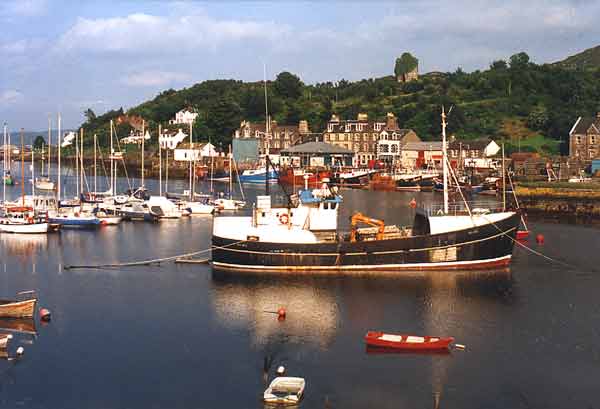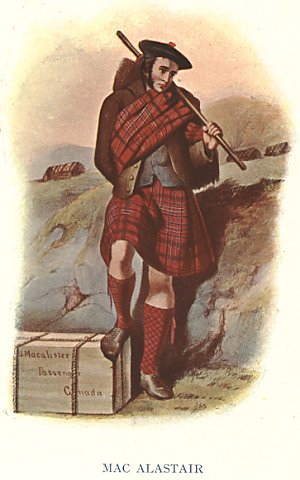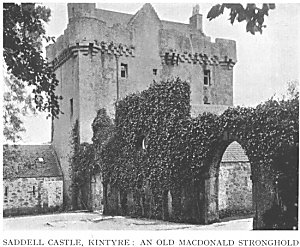|
The MacAlisters descend
from Alasdair Mor a younger son of Donald of Islay, founder of Clan Donald and
great-grandson of King Somerled. The descendants of Alasdair Mor settled mainly in South
Knapdale (Kintyre) and in 1481 Charles MacAlister was invested with the Stewartry of
Kintyre by James III. The principal family was the MacAlisters of Loup who were supporters
of the royal house of Stewart. Alexander, 8th of Loup fought at Killiecrankie with Bonnie
Dundee. He was succeeded by his brother Charles, who married a daughter of Lamont of that
Ilk. Charles, 12th of Loup, married Janet Somerville, an heiress of Kennox in Ayrshire.
The MacAlisters of Loup and Kennox have since sold their seat at Kennox. The present chief
was recognised in 1991 by the Lord Lyon as being the rightful chief of the clan. He is the
17th chief of Clan MacAlister. Other important cadet branches include the MacAlisters of
Tarbet who became the Hereditary Constables of the Royal Castle of Tarbert on behalf of
the Earls of Argyll. One other branch established itself at Glenbarr in Argyll, and
another took the name of Alexander and settled in Menstrie in Clackmannanshire as vassals
of the Earl of Argyll, many of this branch later settled in Ireland in the 17th century
and became Earls of Caledon.

Tarbert with Castle in the background.
Photograph by Scottish
Panoramic.
Another account of the Clan
BADGE: Praoch
gorm (erlea vulgaris) common heath
 WHILE
several of the Highland clans, like the MacGregors and MacQuaries, could,
by reason of their descent from the Scots king Alpin, support their
dignity with the proud boast, "Royal is my race," there were
others to whom it was open to make an almost equal claim by reason of
their descent from the ancient princes and lords of the Isles. Among those
who could in this way claim to be of the blood of the mighty Somerled
were, first of all, the MacDonalds and MacDougalls, and deriving from them
were lesser clans, like the MacIans of Glencoe and the MacAlastairs of
southern Argyllshire. WHILE
several of the Highland clans, like the MacGregors and MacQuaries, could,
by reason of their descent from the Scots king Alpin, support their
dignity with the proud boast, "Royal is my race," there were
others to whom it was open to make an almost equal claim by reason of
their descent from the ancient princes and lords of the Isles. Among those
who could in this way claim to be of the blood of the mighty Somerled
were, first of all, the MacDonalds and MacDougalls, and deriving from them
were lesser clans, like the MacIans of Glencoe and the MacAlastairs of
southern Argyllshire.
The MacAlastairs trace
their descent in the famous MS. of 1450, from the great-grandson of
Somerled, Angus Mor MacDonald, Lord of the Isles in the latter part of the
thirteenth century. Angus Mor had two sons, Alexander, or Alastair, and
Angus Og, and it is from the former of these that the MacAlastairs take
their patronymic. Alexander of the Isles added considerably to his power
and territories by marriage with one of the daughters of Ewen de Ergadia,
otherwise John of Argyll. This connection, however, brought him into
serious trouble, for his relation by marriage, Alexander of Argyll,
married the third daughter of John, the Red Comyn, slain by Bruce in the
church of the Minorites at Dumfries. In consequence of that event
Alexander of Argyll and his son John of Lorn became Bruceís most bitter
enemies. They were naturally supported by Alexander or Alastair of the
Isles. Accordingly, after Bruce had finally defeated John of Lorn at the
Bridge of Awe, and captured Alexander of Argyll in the stronghold of
Dunstaffnage, he turned his attention to crushing Alexander of the Isles.
For this purpose he had his galley drawn, like that of Magnus Barefoot
before him, across the isthmus at Tarbert, and besieged the Island Lord in
Castle Sweyn, his usual residence. Alexander was forced to surrender, and
was forthwith imprisoned in Dundonald Castle in Ayrshire, where he died.
At the same time his possessions and lordship of the Isles were forfeited
and given to his younger brother Angus Og, whose support had been of so
much value to the warrior king, and who figures as the hero of Sir Walter
Scottís famous poem.
From their descent as
legitimate heirs male of the forfeited Alexander of the Isles, the
MacAlastairs may claim to be the actual representatives of the mighty
Somerled.
The principal seat. of the
MacAlastair chiefs in early times was at Ard Phadruic on the south side of
Loch Tarbert The nearest cadet of the house, MacAlastair of Tarbert was
Constable of Tarbert Castle, the stronghold built by Robert the Bruce
himself after subduing Alexander of the Isles, and, among other positions
of honour and power, the Stewardship of Kintyre was held by Charles
MacAlastair in the year 1481.
After the forfeiture, in
the latter part of the fifteenth century, of the later line of Lords of
the Isles, which inherited the turbulent blood of King Robert II. from a
daughter of that king, the MacAlastairs attached themselves for a time to
the powerful tribe of the MacDonalds known as Mac Ian Mhor, whose founder
John the Great had flourished in the year 1400. They soon, however,
attained the dignity of an independent clan. By this time the seat of the
chiefs was at Loup in the Cowal district of Loch Fyne, and in 1587, when
King James VI. passed the Act known as the "General Band," or
bond, making the Highland chiefs responsible to the Crown for the good
behaviour of their clansmen and the people on their lands, "the Laird
of Loup" appears in the list as one of those made accountable. This
laird, Alastair MacAlastair, died while his son Godfrey, or Gorrie
MacAlastair, was still a minor.
 The
great house of Argyll was then rising to the height of its power, and
doing its best by every sort of means to increase its territories and the
number of its vassals. It was probably as a result of one of its schemes
that in 1605, all the chiefs of the Isles and West Highlands were ordered
to appear at Kilkerran, now known as Campbeltown, in Kintyre, exhibit the
titles to their lands, renew allegiance to the Crown, and give securities
for their loyal behaviour. Lord Scone, Comptroller of Scotland, was
appointed Commissioner on the occasion. To enforce compliance all the
fencible men of the western counties and burghs were ordered to assemble
in arms at the appointed place, and all boats were to be put in possession
of Lord Scone. In case of non-attendance, the Highland chiefs were to be
treated as rebels, and subjected to forfeiture and military execution. The
great house of Argyll was then rising to the height of its power, and
doing its best by every sort of means to increase its territories and the
number of its vassals. It was probably as a result of one of its schemes
that in 1605, all the chiefs of the Isles and West Highlands were ordered
to appear at Kilkerran, now known as Campbeltown, in Kintyre, exhibit the
titles to their lands, renew allegiance to the Crown, and give securities
for their loyal behaviour. Lord Scone, Comptroller of Scotland, was
appointed Commissioner on the occasion. To enforce compliance all the
fencible men of the western counties and burghs were ordered to assemble
in arms at the appointed place, and all boats were to be put in possession
of Lord Scone. In case of non-attendance, the Highland chiefs were to be
treated as rebels, and subjected to forfeiture and military execution.
It can easily be seen how
an order of this kind could be turned to account by the House of Campbell.
There are traditions still extant in Campbeltown of a similar requisition
being made at a later day by the mother or wife of one of the Dukes of
Argyll, who professed to be of an antiquarian taste which she wished to
satisfy by a perusal of the titles of the Kintyre lairds. Unwilling to
disoblige so great a dame, the lairds brought her their family papers. In
due course, by an "accident," these papers were lost or
destroyed, and as a result, the lairds had to get new titles from the
Duke, in which he duly appeared as granter and feudal superior, while
they, of course, appeared as holding their lands of him as his vassals.
Only one family, it is said, escaped this misfortune. It owed its escape
to the shrewdness of a servant. This man, doubting the good faith of the
Duchess, disappeared with his masterís title deeds and other papers, and
took care not to return till all danger was past.
By one or other of these
enterprises of the House of Argyll the MacAlastair chefs, appear to have
lost their patrimony in Knapdale, and to have had their possessions in
Argyllshire confined to the lairdship of Loup.
In 1618 the Laird of Loup
was one of twenty barons and gentlemen of the shire who were made
responsible for the maintenance of order in the earldom during the absence
of Argyll. He was now the earlís vassal, and accordingly when the Civil
War broke out and the Marquess of Montrose took arms for Charles I. in
Scotland, MacAlastair himself remained at home, though many of his
clansmen joined the Royalist forces.
The chief of that time
married Margaret, daughter of Campbell of Kilberry. A century and a half
later, in 1792, Charles MacAlastair of Loup married Janet Somerville,
heiress of Kennox in Ayrshire, and, in right of his wife, in 1805 added
the name and arms of Somerville to his own. From that time the family was
known as Somerville MacAlastair of Loup and Kennox.
Sept of Clan MacAlastair: Alexander
|
|
Some additional information...
A
clan at one time of considerable importance, claiming connection with the great clan
Donald, is the Macalisters, or MacAlesters, formerly inhabiting the south of Kanpdale, and
the north of Kintyre in Aryleshire. They are traced to Alister or Alexander, a son of
Angus Mor, of the clan Donald. Exposed to the encroachments of the Campbells, their
principle possessions became, ere long, absorbed by different branches of that powerful
clan. The chief of this sept of the Macdonalds is Somerville MacAlester of Loup in
Kintyre, and Kennox in Ayrshire. In 1805 Charles Somerville Macalester Esq. of Loup,
assumed the name and arms of Somerville in addition to his own, in right of his wife,
Janet Somerville, inheritrix of the entailed estate of Kennox, whom he had married in
1792.
From their descent from Alexander, eldest son of Angus Mor, Lord of the Isles and Kintyre
in 1284, the grandson if Somerled, thane of Argyle, the MacAlesters claim to be the
representatives, after MacDonell of Glengarry, of the ancient Lords of the Isles, as heirs
male of Donald, grandson of Somerled.
After the forfeiture of the Lords of the Isles in 1493, the MacAlesters became so numerous
as to form a separate and independent clan. At that period their chief was names John or
Ian Dubh, whose residence was at Ard Phadriuc or Ardpatrick in South Knapdale. One of the
family, Charles MacAlester, is mentioned as steward of Kintyre in 1481.
Alexander MacAlester was one of those Highland chieftains who were held responsible, by
the act "called the Black Band", passed in 1587, for the peaceable behaviour of
their clansmen and the "broken men" who lived on their lands. He died when his
son, Godfrey or Gorrie MacAlester, was yet under age.
In 1618 the laird of Loup was named one of the twenty barons and gentlemen of the shire of
Argyle who were made responsible for the good rule of the earldom during Argyll's absence.
He married Margaret, daughter of Colin Campbell of Kilberry, and though as a vassal of the
Marquis of Argyll, he took no part in the wars of the Marquis of Montrose, many of his
clan fought on the side of the latter.
The principle cadet of the family of Loup was MacAlester of Tarbert. There is also
MacAlister of Glenbarr, county of Argyle.
Name: Lynn McAlister
email: rolymac@prodigy.net
Comments:
Regarding your webpage history of the clan MacAlister, you have made a
formerly common, but now universally rejected, error in naming as the clan's
founder Alexander of the Isles (aka Alasdair Og MacDonald), son of Angus
Mor. In fact, this clan descends not from Angus Mor's older son but from his
younger brother, Alasdair Mor (thus the uncle of Alexander of the Isles).
Any current text on Scotland's clans clearly states that Alasdair Mor, not
Alasdair Og, is the progenitor of this clan. (See, for example, "Scottish
Clan and Family Encyclopaedia" by Way and Squire; "Collins Encyclopedia of
Scotland", ed. Keay and Keay; "Scottish Highlanders" by Charles MacKinnon of
Dunakin; and the Clan Donald webpage, among others.) Furthermore, the
present chief of the clan, Wm. McAlester of Loup, traces his descent
directly to Alasdair Mor. This is significant for two reasons: first, while
Alexander of the Isles was an ally of the Lord of Lorn against Bruce and was
killed (1308)after Lorn's defeat, Alasdair Mor actually died in battle
*against* Lorn (in 1299), which indicates that whatever his views of Robert
Bruce, he was certainly no ally of Bruce's MacDougall opponent. Secondly,
Alexander of the Isles lost his Scottish lands, and his descendants are
found in northern Ireland, where they use the MacDonald, not the MacAlister
surname. Alasdair Mor's descendants, on the other hand, remained in
Scotland. If the younger Alasdair were, as you claim, the MacAlister
progenitor, this clan would not be associated with Kintyre, as they are to
this day.
I hope that you will amend this error in the interest of providing accurate
information to your web site visitors.
Lynn McAlister
Clan Historian, Clan McAlister of America |

